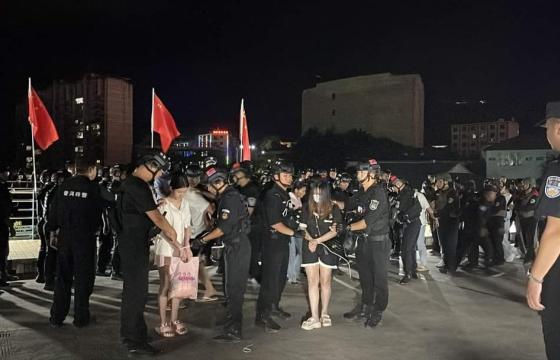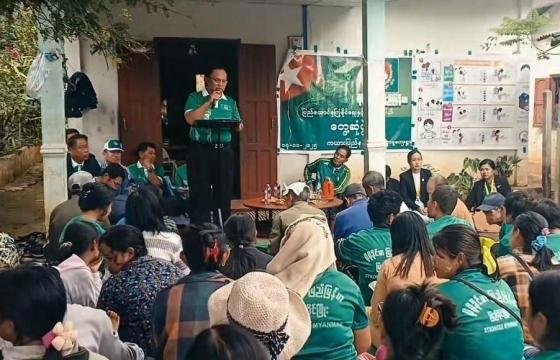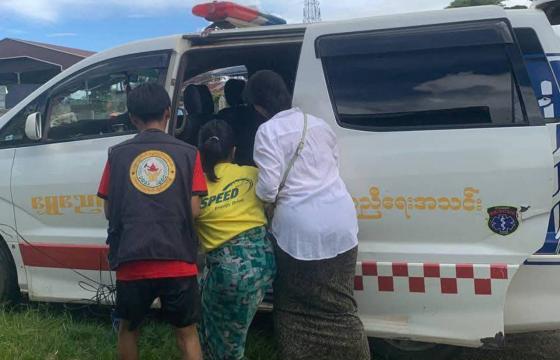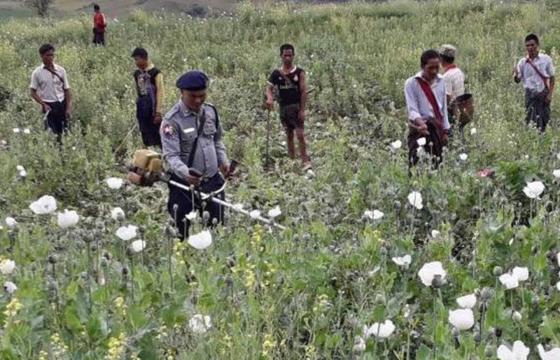Burma or Myanmar ethnic conflict wars are fought by the military or Tatmadaw using coded colors. White is an insurgent free government control area; brown a contestant territory; and black no-man’s land or free-fire zone.
The northern part of Arakan or Rakine State and the adjacent Paletwa area of Chin state are a mixture of brown and black areas. But the fluctuation of pinpointing the color-coded areas are high given the constant movement of Arakan Army (AA) troops due to the nature of their guerrilla warfare employment, and as well depending on the Tatmadaw duration of physical garrison and stationing in the areas that it has managed to wrestle from its adversaries and control them.

Photo by – securityforcemonitor.org/ Myanmar Army in Rakhine State: 1995 to 2018 – a map by Security Force Monitor (CC-BY-4.0)
The recent development of not being unable to sign the bilateral ceasefire between the Northern Alliance – Burma (NA-B), whose four military alliance are AA, Kachin Independence Army (KIA), Myanmar National Democratic Alliance Army (MNDAA) and Ta’ang National Liberation Army (TNLA), and Tatmadaw doesn’t bode well for the peace process.
This is because the AA and Tatmadaw don’t see eye-to-eye on the former’s stationing in Arakan State as its ethnically given rights, while the latter is of the opinion that it has started out in Laiza, Kachin State and therefor only belongs there. In other words, AA is not accepted by the Tatmadaw in Arakan State, which is formerly a white, government control, area and has to be driven out and restore order.
The situation is now geared to escalate as the government on June 22 has ordered to cut off internet connection in all contested areas of northern Arakan and adjacent Chin State of Paletwa, where most armed conflicts are raging and ongoing.
The heightened armed conflict between the Tatmadaw and AA starting from last December has resulted in various human rights violations against the civilian population which are against the international human rights norms. The situation is also threatening to derail the nascent democratization process.
But first let us look at the present situation on the ground.

Rakhine ethnic people, who fled from a conflict area, gather at War Taung village’s temporary camp, in Kyauk Taw Township, in northern Rakhine State, Myanmar, on January 3rd. 2019. Photograph: Nyunt Win
Recent happenings
Recent reports of the Tatmadaw mass detention to weed out AA elements have become so intensified that questions relating to human rights violations and legality to conduct such actions are being asked by domestic and international rights groups alike, including the civil society organizations and general public.
On April 31, 275 villagers from Kyauk Tan village, Rathedaung township in northern Arakan State, under suspicion of having ties to the AA were detained by the Tatmadaw. And on May 2, while the villagers were being held, six were shot dead and eight injured, when the captives tried to snatch guns from the soldiers, according to the Tatmadaw version of clarification. Family members of those killed were not allowed to see the bodies at the funeral ceremony, while eight others were wounded and four were missing. The military stated that six of the detainees admitted to being members of the Arakan Army (AA) and the other 2 are suspects were sent to the Sittwe Myoma Police Station and the other detainees were released.
Myanmar National Human Rights Commission (MNHRC), the government’s human rights organ, later try to whitewash the incidence in its report as an accident which arises from misunderstanding when a deranged individual shouted and ran in the middle of the night, making many of the captives fleeing in all directions. Those who fled in the directions where armed guards were stationed were shot dead or wounded in the panic situation. The report however failed to pinpoint the perpetrators that would lead to their persecution.
On June 10 morning, Tatmadaw troops numbering about 50 personnel, together with six policemen, came to a monastery in Pauk Taw Byin village in Ponnagyun township sheltering about 800 villagers from around the area to inspect the camp for suspicion of harboring AA members.
However, U Arrekha, senior monk of the monastery and the head of the refugee camp refused entry saying that they should not be in uniform if they come for inspection. Some 200 villagers fled the monastery during that time for fear that the situation would be like in Kyauk Tan village detention where six were killed.
The next day, on June 11, five military personnel, two policemen and two immigration staff are allowed to enter the refugee camp to carry out inspections. The joint team did not interview villagers but photographed some people, said the monk. A rare kind of concession from the part of the military to show that it is going by the book, which could possibly be because high media scrutiny.
According to the media, the internally displaced persons (IDPs) in Arakan State has reached nearly 50,000 and increasing as the Tatmadaw’s harassment of the villagers continued, combined with random shooting at villages along the road in several places during military convoy movements causing deaths and wounding the villagers since early this year. Indiscriminate shelling of population settlements occurred quite often, including abduction of villagers at will which many said to have disappeared without a trace.
The Voice of America recent report on June 17 said more than 70 persons have now been detained by the Tatmadaw on suspicion that they are connected to the AA and were charged with unlawful association with illegal organizations act and anti-terrorism law.

Photo by : time.com / In this photograph taken on October 21, 2016, armed Myanmar soldiers patrol a village in Maungdaw located in Rakhine State as security operation continue following the October 9, 2016 attacks by armed militant Muslim.
The United Nations called for an investigation into claims Myanmar troops have been killing civilians and torching villages in northern Rakhine, as reports emerged thousands of Rohingya had been forced from their homes. / AFP / STR (Photo credit should read STR/AFP/Getty Images)
Amnesty International report
The new Amnesty International (AI) report, “No one can protect us”: War crimes and abuses in Myanmar’s Rakhine State, details how the Tatmadaw, have killed and injured civilians in indiscriminate attacks since January 2019. Its forces have also carried out extrajudicial executions, arbitrary arrests, torture and other ill-treatment, and enforced disappearances.
The report examines the period of intense military operations that followed coordinated attacks on police posts by the Arakan Army (AA) on January 4, 2019. The new operation followed a government instruction to ‘crush’ the AA.
“The new operations in Rakhine State show an unrepentant, unreformed and unaccountable military terrorizing civilians and committing widespread violations as a deliberate tactic,” said Nicholas Bequelin, Regional Director for East and Southeast Asia at Amnesty International.
AI conducted 81 interviews, including 54 interviews on the ground in Rakhine State in late March 2019 and 27 remote interviews with people living in conflict-affected areas.
- From interviews and other evidence, including satellite imagery, AI documented seven unlawful attacks which killed 14 civilians and injured at least 29 more.
- It said the army was involved in at least seven unlawful attacks that killed 14 civilians and wounded 29. In one incident in late January, a seven-year-old boy died after he was denied access to emergency medical treatment following a mortar attack.
- In another incident in mid-March, a mortar blast wounded four people and destroyed the home of Hla Shwe Maung. Satellite imagery confirmed a building had been destroyed.
- The report also detailed abuses against Rohingya, including a helicopter attack on civilians cutting bamboo. At least six people, including boys, were killed and 13 wounded.
- AI noted the Myanmar military’s “four cuts” strategy under which it aims to deny rebel groups access to “food, funds, intelligence and new recruits” was having a significant effect on the local population both in Rakhine and neighboring Chin State.
- AI also documented the enforced disappearance of six men – one ethnic Mro and five ethnic Rakhine – in mid-February. A witness said she last saw one of the men in military custody. Since then, families have had no information about their loved ones’ fate and whereabouts.
- AI also documented how the military has taken positions within ancient temple complexes of Mrauk-U and fired recklessly in the area. Satellite imagery confirms the presence of artillery close to the temples, and photographs show destruction of temple sites. While the organization has not been able to determine who was responsible for the attacks, by basing themselves close to the monuments, the Myanmar Army exposed historical and cultural property to destruction and damage, which violates international humanitarian law.
- The seven soldiers convicted of involvement in Inn Din massacre of 10 Rohingyas in September 2017 have been given early release having served less than a year of their 10-year sentences.
Previous three decades of Tatmadaw indiscriminate attacks and willful killings
A study titled “Policy Memorandum: Preventing Indiscriminate Attacks and Willful Killings of Civilians by the Myanmar Military”, published by International Human Rights Clinic at Harvard Law School in March 2014 summarized the situation as below:
Civilians in conflict zones across Myanmar have been vulnerable to indiscriminate attacks and willful killings by the military for decades. Various commentators and academics have noted that “free-fire zones” have existed in ethnic minority areas since the late-1960s. In the three decades prior to the inauguration of the Thein Sein government, international organizations and domestic human rights groups documented widespread attacks on civilians in Myanmar. For example, in the late 1980s, Amnesty International documented severe human rights violations, including “unlawful and deliberate killings” against civilians of Karen, Karenni, Mon, Kachin, and Shan ethnicity. In 1998, the Shan Human Rights Foundation published a report alleging 664 extrajudicial killings by the Myanmar Army in a single year, which included shootings of unarmed civilians as well as mass executions. The report, referencing forced displacement by the government, stated that “the regime’s troops . . . systematically [killed] villagers caught outside the relocation sites in a program to deter others from going back to their original villages.” This report was corroborated by another from Amnesty International, which described a massive military campaign in which 300,000 civilians were displaced and “hundreds [were] killed when they attempted to return to their farms.”
Military doctrine
The same study wrote: “For decades, the Myanmar military has engaged in indiscriminate attacks and willful killings of civilians within its own borders. These actions, which are clear violations of international humanitarian law, have caused the death of thousands of civilians and have been a major factor in the massive displacement in the country. Throughout Myanmar’s history, government forces have routinely attacked civilian populations as part of centrally-planned counterinsurgency offensives.”
The military has targeted civilians through “shoot-on-sight” incidents, extrajudicial executions, indiscriminate shelling, and the purposeful use of landmines to inflict civilian casualties.
“A central aspect of the Myanmar military’s counterinsurgency strategy has been the labeling of geographic regions with color-designations—black, brown, and white—according to the extent of government control. “Black areas” are territories over which the Myanmar government exercises little or no control, “brown areas” are areas in which government control is contested, and “white areas” are those in which government control is strong,” wrote the report.

Photo by : news.sky.com / A Myanmar border guard watches over a group of Rohingya in a village in Rakhine
Analysis
Given such development and scenarios, it could be concluded that the Tatmadaw isn’t going to give up its counterinsurgency doctrine of placing military objective victories over humanitarian concern of the ethnic population. Moreover, the Tatmadaw has indoctrinated its troops for decades to believe that all non-Bamar ethnic groups are not to be trusted and are all potential enemies. Its conduct of mass detention in Arakan state in hundreds, pressing scrutiny and interrogation in refugee camps, and ongoing recent random arresting of civilians within the Arakan State by the military intelligence, show how distrustful it is on the local population as a whole.
The recommendation to the Tatmadaw that it should reform in order to be in tune with the democratization process is not heeded. Its approach now seems just to reap the legitimacy credential of a democratic country by posturing as an organ under the popularly elected National League for Democracy (NLD) government, without being answerable to the democratic principles of universal human rights, which every humane government should adhere to.
True, the Tatmadaw has secured the go ahead of the NLD government to wage war against the AA in Arakan state but it doesn’t mean that it could abandon universal human rights norms, especially those that would inflict the local population and put them in harm’s way.
And as the Tatmadaw and its commander-in-chief have made known time and again that 2008 military-drafted constitution will be protected at all cost which means that the Tatmadaw will play the leading role in the country’s political arena, although it is said to be willing to go along with minor changes that won’t dilute its political decision-making supremacy position.
In short, while the commander-in-chief often aired its reforming the Tatmadaw to be a “standard army” quite often, its primary aim is to become a well-equipped fighting force with modern weaponry, it is in no way interested to become a reformed, democratic army, much less the “federal union army” envisaged by the ethnic nationalities in the country’s democratization process.
For now, the Nationwide Ceasefire Agreement-based peace process is stalled since last November, the ongoing bilateral ceasefire talk deliberation is also not moving ahead due to the disagreement with the AA stationing in Arakan state, and the cutting off of internet access in the contestant areas of Arakan and Chin States, all indicate that the war will escalate and go on unabated.
Thus, the Tatmadaw will continue to function as it has always been and that is to achieve its military victory objectives at all cost, even at the expense of the civilian sufferings, which would amount to crimes against humanity seen from the universal human rights norms.
It would do all stakeholders good, if the Tatmadaw would rethink and remold its mindset of military victory at all cost to opt for solution through political means, by being more accommodating and flexible in going about with the peace process.







